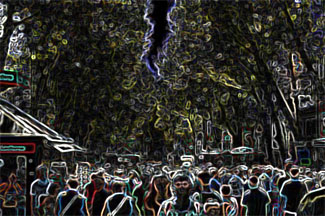The demographic filter of Barcelona

As a consequence of migration and residential mobility experienced in Barcelona during the last decade, Barcelona is now a city with a greater presence of young adults, singles, professionals and the highly educated. Since Barcelona's central municipality reached its urban and demographic maturity one third century ago, migration and residential mobility have been the determinant factors of its sociodemographic renewal. In many other inner cities it has been proved that participants in residential flows (moving into, moving out and moving within the urban core) are not randomly extracted from the whole population. Barcelona's demographic filter deals to distinguish the individuals leaving the city from the ones who decide to change their home within the inner city, as well as the ones moving into the city from the ones who don't include the central city in their residential itineraries. Over these points is built the PhD dissertation “Residential changes and migration movements in the population's renewal of Barcelona”, written by Antonio López Gay and directed by Dra. Anna Cabré and Dr. Joaquín Recaño, and developed in the UAB's PhD program in Demography.
The family dimension involving the change of residence is one of the main aspects that defines the leaving the city movements in the age at leaving home. Almost eight of every ten young adults aged between 25 and 34 leaving Barcelona live with a partner or children in the new residence. However, the proportion descends to 60% when the movements within the city are analyzed, and it is below the 50% when all the arrivals to the city are counted up. For the very first time in the demographic history of Barcelona, the married population does not exceed the single population until they are almost 40 years old, a process in which migration and residential mobility have played a key role, in addition to the well-known behavior change in terms of nuptiality. Therefore, singles in young adult ages not only put down roots in the city because they are less likely to move, but also because of the demographic filter of Barcelona, which keeps in the city not married and not cohabiting population once they have started the residential movement.
Regarding age and sex, the combination of two processes, international immigration and leaving the central city movements because of residential reasons, has rejuvenated the demographic structure of Barcelona's population (see Figure). Thus, boomers generations, born in Spain between 1965 and 1975, have definitely lost their leading role in the population structure, one feature that had characterized Barcelona's demographic pyramid since they were born. In that sense, is expected that modal age in Barcelona's population will remain in the range of the 25-30 years old, reproducing processes experienced in other European central cities as Paris and London.
Educational attainment of residents in Barcelona's inner city doesn't explain the intensity of the residential change, but it defines their final destination, hence, their territorial distribution. In terms of the educational attainment, Barcelona's sociodemographic filter can be synthesized in its capacity to retain the highly educated and the permissibility to allow leaving the urban core to individuals who only have completed the compulsory education. In the migratory flows, selectivity strengthens the arrival of highly educated population, especially when they are arriving from the rest of the Metropolitan Area or Spain.
From a socioeconomic approach, professionals and active women are the most likely groups to remain in the central city, while manual workers and inactive women are more willing to leave the urban core. In the moving into the city movements, new residents arriving from the Metropolitan Area present a similar profile with those who change of dwelling within Barcelona. Meanwhile, the internationalization of the migratory flows has subtracted intensity to the process of professionalization derived of Metropolitan movements.
Finally, the result of introducing dwelling variables to the residential model of Barcelona's inner city points out that Barcelona's sociodemographic filter allow to leave the city to those who want to satisfy their residential preferences --as far as the housing tenancy and dwelling surface are concerned. However, neither the newly arrived population nor those who change residence within Barcelona are able to reproduce the behavior of those who leave the city, and are more willing to live in rented and smaller flats.
References
López Gay, Antonio (2007) "Canvis residencials i moviments migratoris en la renovació poblacional de Barcelona" Tesi Doctoral dirigida per la Dra. Anna Cabré i el Dr. Joaquín Recaño, llegida el 24 d'abril de 2007, programa de doctorat en Demografia, Departament de Geografia de la UAB i Centre d'Estudis Demogràfics.


